|
Sri Lanka
Caribbean Destinations | Pacific Destinations | Indian Ocean Destinations | Pacific Newsletters | Indian Ocean Newsletters | Flora and Fauna
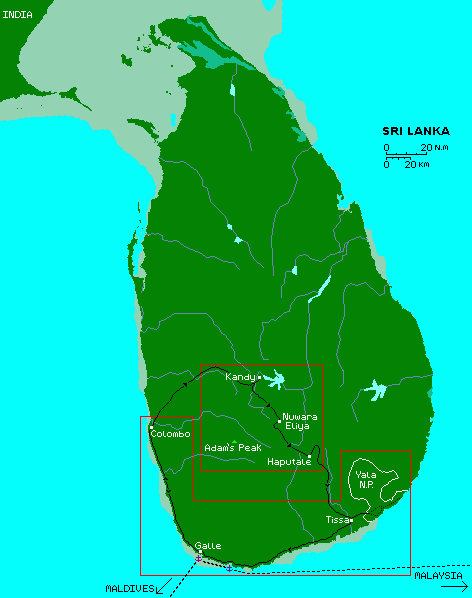
Click on the map to go to our description of that area |
Language: Sinhala and Tamil, with Sinhala spoken by about 75% of
the people. English is used widely.
Population: Sri Lanka's population of almost 20 million is divided
into 2 major religious groups: the Buddhist Sinhalese who arrived from northern
India in the 6th century, and the Hindu Tamils who are subdivided into those in
the north who are fighting for freedom, and the "hill Tamils", descendants of
Tamil workers brought to Sri Lanka by the British in the 19th century. There is
a small Muslim population of Pakistan, Indian and Malay descent.
Money: Sri Lankan rupees, with about 103Rs to US$1 in 2007
Landscape: Green and lush in the center and south. The north is more
arid, as is SE , especially around the Yala National Park area. The interior
is quite rugged and hilly, with dense forests and steep gorges and rivers.
Visited: 10 March to 26 March, 2007.
History: Prior to the 6th century BC, the island of Sri Lanka was
inhabited by stone age peoples: the Veddahs. When the Sinhalese arrived from North India
in the 6th and 5th century BC, they formed the kingdom of
Anuradhapura. Buddhist teachings spread from India, and the kingdom's history is
enmeshed with the stories of Buddhism. The 1st century BC the Theravada
school of Buddhism was established, and spread later to Thailand and SE Asia.
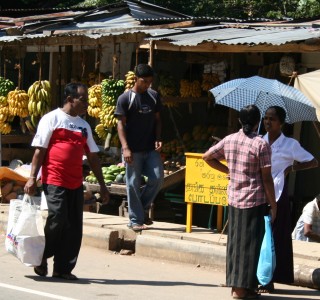
Typical Sri Lanka highlands street scene |
Centuries of unrest followed the arrival of
South Indians to the island. In the 11th century AD,
King Vijayabahu moved his capital from Anuradhapura to Polonnaruwa, and although
several kings built irrigation systems and public buildings, some were more
war-like, and after only 2 centuries the capital was abandoned, and like
Anuradhapura before it, quickly re-claimed by the jungle.
Meanwhile other peoples settled on the island: Hindu Tamils from South India
in the north, and Muslims who arrived in trading boats interested in gems,
spices, and ivory. When the Portuguese arrived in 1505 they formed cordial
relations with the Sinhalese kingdom on the coast near today's Colombo, but were
unable to win over the Sinhalese in the hill country around Kandy, or the Hindu
Tamils who resented the attempts to convert them to Catholicism. A century
later the Dutch arrived, and as was normal, were more interested in trade than in
conversion. They quickly formed an alliance with the Tamils of Kandy and
made a treaty that gave the Dutch a monopoly on the spice trade, thus ridding the
island of the hated Portuguese. Roman-Dutch law was instituted, and remains
as a basis of much of the legal system in Sri Lanka today.
|
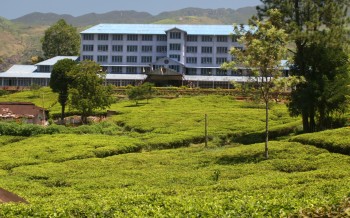
Blue Fields Tea Factory |
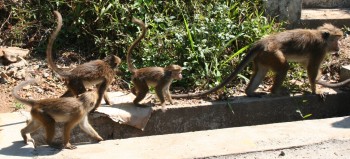
Macaque monkeys can be found most places |
Enter the British in the later 1700's, who ousted the Dutch in 1796, and
established an important port on the northeastern coast at Trincomalee. Able to
win control over Kandy, they became the first European country to rule the
entire island. But the Sinhalese (who held the Sacred Relic of Buddha's tooth,
thereby giving them believed power to rule) remained uncooperative, and refused
to work in the coffee and later tea plantations. Consequently, the British
imported hundreds of thousands of South Indian Tamils to work the fields, thus creating
the the "hill Tamils" of today. In 1948 Ceylon (as it was known then)
became an independent member of the British Commonwealth. English was retained
as the official language for another 10 years.
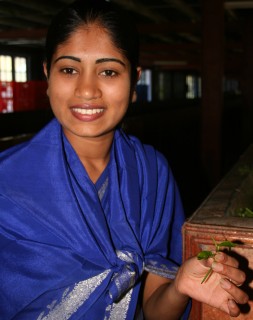
Our Blue Fields Tea Factory guide |
Internal unrest led to the Hill
Tamils losing their citizenship, and it took another 25-30 years for them to
regain it. (India invited them to be repatriated, but most declined.) In the
1956 election a Sinhalese named Bandaranaike won and he promptly instituted
Sinhalese as the only language and voiced paranoia about the Tamils being
supported by the Indians. Violence flared, thus beginning years of strife
between the Tamils and Sinhalese which continues to this day. Following
Bandaranaike's assassination, his window became the world's first woman prime
minister and continued her husband's nationalistic policies. In the 1970's a
Marxist insurrection led to the deaths of about 25,000 people but resulted in a
changed constitution and the country's new name of Sri Lanka. Mrs. Bandaranaike
was roundly defeated in the 1977 elections.
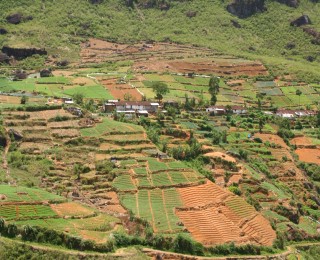
Typical high-country village |
The last 30 years have seen years of peace and moments of intense violence as
the Tamils and Sinhalese still struggle to live together. Ethnic riots erupted
in 1958, 1977, 1981, 1983 (one of the worst) and again in the late 1980's with
30-60,000 people killed. International peace missions have had varied
successes and failures since 2003. As of 2007, the Liberation Tigers of
Tamil Eelam (LTTE, referred to as the Tamil Tigers) control a region in northern
Sri Lanka, and another south of Trincomalee. Bombings and other acts
of terrorism continue.
Ocelot's Overview: Just before we left Thailand at the end of February
we made a last-minute decision to sail to Sri Lanka instead of straight to the
Maldives. We needed somewhere we could let Chris fly back to the States
without breaking the bank, and most of the family wanted to see something of the
Indian Subcontinent. But the anchorage at Cochin, India, was going to be
an up-wind sail so we decided to give up that idea. Sri Lanka was an
enticing alternative, the civil war not-withstanding. It turned out to be
a very good decision, as we loved Sri Lanka!
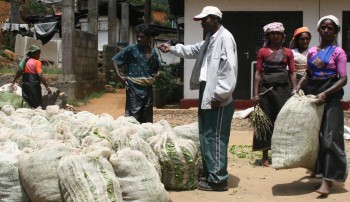
Tea pickers bringing in their harvest |
But Sri Lanka is definitely a country at war - soldiers with AK47 class machine
guns are everywhere, on the lookout for the separatist Tamil Tigers who already
control a large section of northern Sri Lanka. Apparently, the Tigers get
much of their funding from the Tamil people of India. Now, we can
understand an ethnic group wanting a land to call their own, but India is
already an ethnically diverse country with over 50 distinct ethnic groups, and
they're much stronger for those different cultures being united
into one country (as is the USA). Look at Bangladesh or even Pakistan -
ethnically purer than India, perhaps, but relatively insignificant in terms of
world power and influence. If all ethnic groups of the world had their own
homelands, we'd be back in the dark ages, with little fiefdoms fighting
stupid wars with each other.
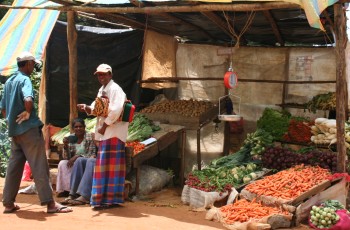
Typical highlands vegetable market |
If India continues to allow money to flow out to the Tamil Tigers, it won't
be long before other Indian ethnic groups decide they want a homeland as well,
resulting in a nasty civil war in India. It would be far better for
everyone if we learned to accept and learn from the different ethnic groups
around us, preserving our own culture if that's important to us individually,
but knowing that we are stronger and more capable if we are united. It's
time the world grew up and learned to embrace our differences and learn from each other.
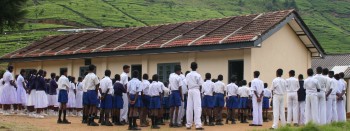
Tea plantation school, with segregated sexes |
All that being said, as travelers we still have to deal with the reality of a
country at war. So how did we handle the US (and other) government warnings against
traveling to Sri Lanka? Realizing that these offices have to cover their backsides,
we know they tend to be extremely cautious. While we might not have been completely
safe in Sri Lanka (where is one ever completely safe?) we do feel we were safer than, say,
on the streets of New York (or any other big city) as there were police
everywhere. Our anchorage in Galle was behind a military compound with
armed guards, and we needed to show passes to get in. Armed guards and road blocks
were in evidence throughout our travels, looking for Tamil Tigers and/or weapons.
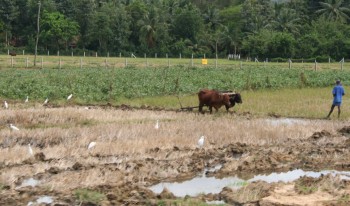
Many fields are still plowed by oxen |
We heeded the travel warnings to the extent that we didn't go anywhere near the Tiger-held
area south of Trincomalee, or to the far north, but otherwise traveled freely and felt
quite safe without giving much thought to the civil war. The 2 military related incidents we
heard of didn't really affect us at all: the small naval ship that docked near us
went out one night and destroyed a pair of Tiger supply ships offshore, and a Tiger light
plane dropped a pair of small bombs on the military airport (which is just next
to the commercial airport) the day after Christopher flew out. Having been
in Venezuela when the US issued its
travel warnings there, we now know to treat these with some skepticism, to do
our own research and then try to put things in perspective. In our travels
around the world we have had to do this in Venezuela, Bali, southern
Thailand, and Sri Lanka. We try to avoid trouble spots when possible, but
also recognize that the chance of an incident happening right when we are there
is minimal. World travel requires a mix of travel smarts, knowledge, and
faith in the goodness of the vast number of people. So far we've managed
to have a wonderful time, go where we want and still feel very safe.
Up | Sri Lanka Coast | Hill Country
| Sri Lanka Newsletters
| Sri Lanka Cruising Info
| Sri Lanka Flora & Fauna
Indonesia | Singapore | Malaysia | Thailand | Nepal | India | Sri Lanka | Maldives | Chagos | Seychelles | Madagascar | Mayotte
Caribbean Destinations | Pacific Destinations | Indian Ocean Destinations | Pacific Newsletters | Indian Ocean Newsletters | Flora and Fauna
Top Level:
Home |
Destinations |
Cruising Info |
Underwater |
Boat Guests |
Ocelot |
Sue |
Jon |
Amanda |
Chris |
Site Map |
Make a Comment
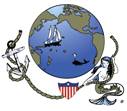 |
Lifetime
Commodores
of the
Seven Seas
Cruising
Association |
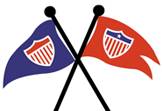 |
|
If our information is useful,
you can help by making a donation
|
Copyright © 2000‑ Contact:
Jon and Sue Hacking -- HackingFamily.com, svOcelot.com.
All rights reserved.











